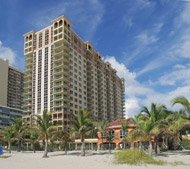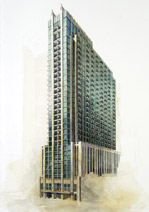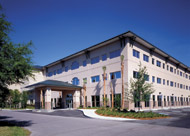|
COVER STORY, FEBRUARY 2005
CONTRACTORS BUSY WITH NEW CONDOS AND
CONVERSIONS
New construction and a recovering economy give Southeast
contractors an optimistic outlook.
Dawn Pick Benson
 |
|
Current Builders constructed
the 212-unit Riviera Yacht Club
in Hallandale Beach, Florida. The Related Group
developed
the 19-story beachfront condominiums.
|
|
As the economy makes a comeback, construction in the Southeast
is once again picking up steam. A desire to capture lower
interest rates and cut down on commute times is fueling a
trend toward downtown condominium construction in cities like
Nashville, Tennessee, and Atlanta. In Florida, destruction
from recent hurricanes has created a continued need for housing.
A focus on smart growth planning is taking place in Atlanta’s
south Fulton County, where a lot of activity is anticipated.
The construction industry is also experiencing commodity and
resource price fluctuations, which has led to cost increases
for contractors. Southeast Real Estate Business recently talked
with several Southeast contractors to discuss these trends
and to find out about new construction activity.
Downtown Demand
The Southeast is seeing a lot of high-rise residential construction,
according to Tom Raney, senior vice president with Atlanta-based
R.J. Griffin & Company. Fueling this trend, according
to Raney, is the fact that money is available and lenders
are willing to invest in successful developers. He says R.J.
Griffin is either planning to build or is currently constructing
high-rise residential projects in Charlotte, North Carolina;
Tampa, Florida; Denver; Houston; Nashville; and Atlanta.
“Demand has proven to be strong for affordable condominium
developments that are sized properly for the market and offer
the right amenities,” says Raney. “The mixed-used
component offers conveniences that make condominium living
more enjoyable and easy. Individual condominium buyers are
snapping units up, and in turn, are fueling more and more
construction.” He says that many people are tired of
long commute times and desire to move back into the city in
a live/work/play environment.
Patti Morgan, president of Morgan & Bartos Constructors,
a majority woman-owned company based in Atlanta, also sees
an increase in demand for in-town living. “In Atlanta,
we’re seeing a huge increase in this trend, which is
driving condominium and multi-use construction,” says
Morgan. “With all the activity going on in downtown Atlanta,
a lot of people are looking to come back into the city.”
According to Bob Douma, senior vice president and general
manager at Batson Cook Company’s Atlanta office, there
are three reasons for this trend toward condominium construction
in Atlanta: First, because of the amount of traffic in Atlanta,
people have a greater desire to be near where they work. They
don’t want to commute and fight the traffic. Second,
younger people are not as enchanted with a suburban lifestyle.
“They’re looking for a lifestyle that has more social
interaction,” says Douma. “They want higher density
living and to be closer to restaurants and public facilities.”
Third, Douma says that interest rates are making it possible
for people to buy higher-priced condos.
Jeff Powers, vice president of project development/pre-con
at Current Builders, says this trend toward condominium construction
is occurring in Florida as well. Developers that were once
building apartments are now seeing a dramatic increase in
demand for condominiums and for-sale product. “The major
growth areas in Florida over the past few years have started
to see significantly less land availability, and that has
sparked urban infill development in a greater proportion,”
says Powers. The fact that Florida has been hit by four hurricanes
recently has also created a continued need for both rental
and for-sale housing.
Other Trends
Currently, the Southeast construction industry is experiencing
commodity and resource price fluctuations, according to Powers.
“Unfortunately, the majority of these fluctuations have
been increases in cost,” he says. Raw materials such
as cement and steel, as well as secondhand-related products,
have dramatically increased in price. “Traditionally,
the market sees a 3 percent annual increase in construction
costs across the board,” says Powers. “This past
year, it’s been 10 percent or even greater.”
The reason for these price increases, says Powers, is a shortfall
in materials and an increase in the price of raw materials.
“We’re losing a lot of raw materials to foreign
construction, which is up predominantly in China,” says
Powers. There are also shortages of raw materials, such as
steel, because it is no longer primarily produced in the United
States. Simple economic principle says that an increased demand
and smaller supply causes prices to rise.
There’s also a flurry of activity in south Fulton County,
a largely untapped area south of downtown Atlanta. “In
south Fulton County, there is a big push for a smart growth
plan,” says Dwight Morgan, principal of Morgan &
Bartos Constructors. He says that a new concept — transfer
of development rights — is being considered in the area.
“It’s an attempt to avoid the sprawl and uncontrolled
growth that has happened in many areas of Atlanta.”
Transfer of development rights allows landowners to sell the
right to build houses on their farms or ranches. In return
for permanently preserving the land, they can get tax benefits
and keep living on the property. Builders, in turn, buy the
development rights. But instead of developing the farmland,
they can transfer the number of homes they could have built
there to nearby land where zoning allows more intensive development.
Morgan says that through this concept, very concentrated development
takes place in a few locations and the rest remains green
space.
According to Patti Morgan, south Fulton County will attract
those looking for a new, environmentally sound way of living
that allows them to get away from the “rat race,”
yet still be convenient to a big city.
Another trend, according to Raney, is that healthcare construction
is very strong right now, and there’s still a big demand
for private schools and churches. In addition, Patti Morgan
says she sees a restart in the speculative office building
market in the Atlanta area, as well as the Southeast. “Projects
that started a year or 2 ago are now coming off the shelf
and getting a new life again,” she says.
What’s New?
 |
|
R.J. Griffin & Company is
currently building Viridian, a 553,000-square-foot,
31-story urban condominium
in Nashville, Tennessee.
|
|
There are numerous new developments underway across the Southeast,
and R.J. Griffin has several under construction. Viridian
is a 553,000-square-foot, 31-story high-rise urban condominium
consisting of a nine-story parking deck and 21 floors containing
305 condominium units. The 31st floor features an amenity
area and pool. Located in Nashville, the structure’s
owners are Novare Group and Giarratana Development. The architect
is Smallwood, Reynolds, Stewart, Stewart and Associates.
R.J. Griffin is also constructing Spire, a 28-story, 728,000-square-foot,
multi-unit apartment/condominium facility located in Atlanta.
There will be 393 units, including two, two-story penthouses.
Amenities will include a half-acre pool, a fitness center,
an outdoor terrace deck and six levels of parking to hold
up to 636 vehicles. The project broke ground in March 2004
and will be complete in August. The owners are Novare Group
and Wood Partners.
Also in Atlanta, R.J. Griffin is constructing Twelve, a high-rise
condominium and hotel with retail space. The project comprises
two sites. The first site will include a 549,405-square-foot,
26-level tower with 101 hotel rooms on the first six floors
and 404 condo units on levels seven to 26. The other site
will hold parking, a 12,000-square-foot ballroom, 10,000 square
feet of retail space and a 5,000-square-foot restaurant. The
owners are Novare Group and Wood Partners.
Pompano Beach, Florida-based Current Builders recently completed
the residential construction and some of the retail at City
Place in downtown West Palm Beach, Florida. It’s a two-city
block complex consisting of multiple structures. They include
three separate five-story residential buildings with 264 apartments,
four separate three-story town homes with 84 units, and a
12-story, 128-unit with retail space below.
The Related Group was the developer. “This was part of
Palm Beach County’s plan to stimulate growth and an upscale
climate in downtown West Palm Beach,” says Powers. “It’s
now attracting some of the most well-known companies to come
in and share retail space.”
Current Builders is also constructing The Moorings at Lantana
in Lantana, Florida. This $50 million upscale project was
designed by Roger Fry and Associates for The Related Group
and Lennar Homes. It consists of a 6.5-acre site with 1.2
million square feet of construction. It includes 357 condominiums
and 21 luxury townhomes. The project consists of seven-, six-
and four-story buildings with retail and commercial space.
There will be a six-story, 200,000-square-foot design-build
parking garage with 585 spaces. Amenities include the marina
on the Intracoastal with ocean access, pools, spas, gazebos,
rooms and skywalks from the parking garage to the buildings.
“The unique thing about this project,” says Powers,
“is that it encompasses several different structural
delivery methods. We did a design-build parking garage, and
we also have conventional concrete construction, poured-in-place
floors with post tension, and tunnel form construction.”
Batson-Cook served as general contractor for Paces 325 Condominiums,
an upscale mixed-use development in Atlanta’s Buckhead
area. The 209-unit, 22-story building includes 275,500 square
feet of residential space, 132,000 square feet of parking
space and 5,000 square feet of retail space. A tennis court,
swimming pool and pool deck are located atop the parking garage
on the fourth floor. The owner is Batard Partners, and the
architect is Cooper Carry.
Batson-Cook recently began construction on the main hotel
at The Cloister on Sea Island, Georgia. The 245,484-square-foot,
five-star hotel of Spanish/European-style architecture will
include 33 luxury suites, a meeting/ballroom, prefunction
room, restaurants, state-of-the-art culinary facility and
a solarium. The owner is The Sea Island Company.
A Look Ahead
Looking ahead to the next 3 to 5 years in the construction
industry, Raney sees more mixed-use construction, including
office, residential, hotel and retail. He says that healthcare
construction will continue to be steady as older facilities
are replaced or renovated to keep up with technology and improved
patient care environments. Private schools and churches will
also continue their building programs. “I also see the
office market coming back slowly,” says Raney. “As
the vacant space continues to fill over the next 2 to 3 years,
the office market will begin to strengthen.”
“A good indicator for us,” says Patti Morgan, “is
the fact that some of the major architectural and engineering
firms are swamped with new projects, as well as old projects
they started a few years ago. It’s a great time for us.”
Douma also has an optimistic outlook on the Southeast’s
construction industry. “There’s a lot more work
out there than there has been since 9/11,” he says. “Industry
was down, but there’s just a lot more activity in the
marketplace right now.”
Office Building Developers
Discover Tilt-Wall Concrete
Construction
Across the Southeast, more and more executive park/office
developers and architects are turning to a type of construction
formerly used primarily for warehouses and manufacturing
facilities. Tilt-wall concrete construction, the use of
pre-cast concrete panels weighing 70 tons or more, has
gone “white collar,” shedding its traditional
“concrete box” image. Recent examples include
the new three-story regional office of Bright House Networks
in St. Petersburg, Florida’s Carillon Park and the
world headquarters of Enovia, a software company based
in Charlotte, North Carolina. Both were built by Seretta
Construction.
 |
|
Summit Professional Plaza
in Brunswick, Georgia, is an example of
a multi-story tilt-wall building.
|
|
These and other new buildings showcase how versatile
tilt-wall designs can be. Concrete panels can be fitted
with a brick snap inlay system, for example, giving
the appearance of a brick building without the expense
of brick. Multi-colored brick patterns add a touch of
executive elegance that enhances the exterior of any
office building. Panels can also be formed with dimensional
surface designs, which can be painted to provide multi-color
accents.
Tilt-wall construction appeals to building owners and
developers for other reasons as well. Panels can be poured
and installed in a fraction of the time required for more
conventional types of construction. In addition, tilt-wall
buildings reflect and diffuse the radiant heat of the
southern sun, significantly reducing energy costs.
Finally, another advantage to tilt-wall construction was
discovered in Florida during the recent hurricanes. Tilt-wall
buildings withstood the impact of high lateral winds substantially
better than buildings of block, pre-engineered metal and
brick. Tilt-wall structures sustained virtually no damage
to exterior panels.
With so many benefits, tilt-wall concrete construction
is likely to continue to grow as an attractive, cost-efficient
alternative for office buildings throughout the Southeast. |
©2005 France Publications, Inc. Duplication
or reproduction of this article not permitted without authorization
from France Publications, Inc. For information on reprints
of this article contact Barbara
Sherer at (630) 554-6054.
|
